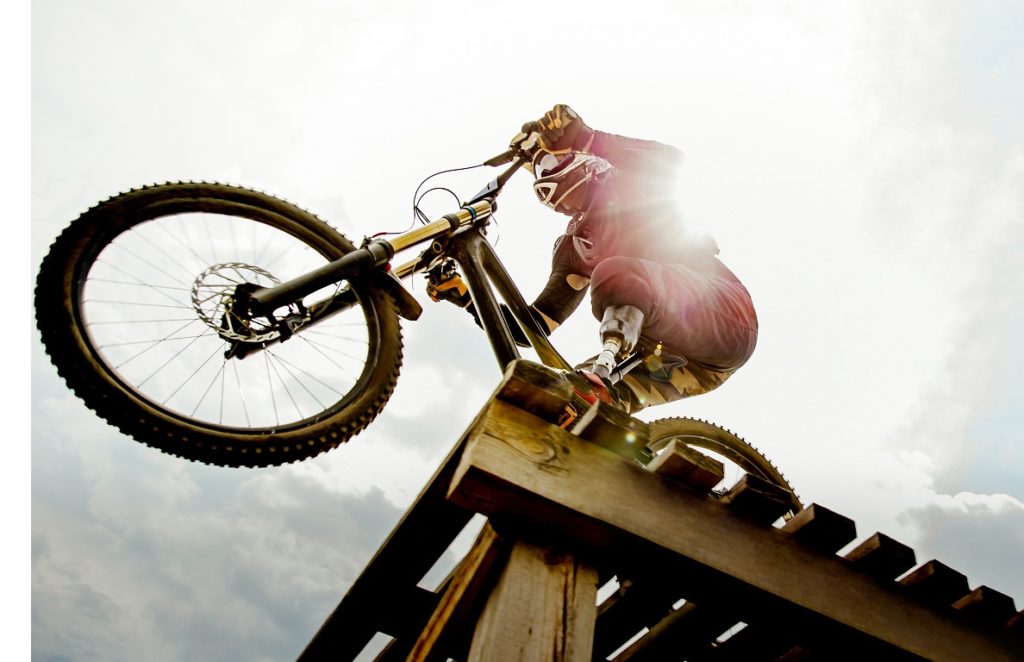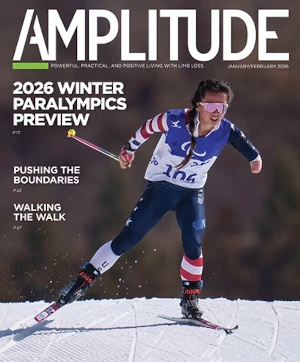We’ve been meaning to write about amputee cycling for a while now. It keeps popping up in the news—there was Bicycling Magazine‘s feature on Leo Rodgers last month, followed by a New York Times article about Paralympic swimmer-tured-cyclist Roderick Sewell, and then our own item about the CO > COVID marathon fundraising bike ride through the Rockies. However, all those stories focused on elite athletes, which most of us aren’t. And you don’t have to be in Paralympic-caliber shape to enjoy bicycling as an amputee….right?

We’ve been starting to wonder. Because while our social media feeds are awash in limb-different runners, weightlifters, crossfitters, rock climbers, dancers, hikers, surfers, etc., limb-different bicyclists hardly ever appear. We don’t quite understand that, because cycling seems like a relaxing way to burn calories, enjoy the sunshine, and get a cardiovascular workout while avoiding the wear and tear that comes with harder-hitting activities.
What we’ve learned is that bicycling’s barriers to participation, while hardly insurmountable, are just high enough to deter many people with either upper-limb or lower-limb difference. Getting past those initial hurdles isn’t prohibitively difficult or costly, but it does take some persistence and maybe a technological accommodation or two. We talked to some regular riders to find out how they’ve managed to incorporate bicycling into their routine—and how it adds to their quality of life.
1. Find the right prosthesis.
One of our main sources is Damian Kevitt, the founder and executive director of LA-based Streets Are For Everyone (SAFE). Kevitt lost his right leg (and nearly his life) in a bicycle accident seven years ago, and he turned the experience into an annual event (Finish the Ride) that promotes traffic safety for everyone on the road, from cyclists to runners, pedestrians, motorists and so on.
Kevitt says many lower-limb amputees don’t enjoy bicycling because they just don’t have the proper leg for it.
“I can cycle with my everyday leg, but it’s not comfortable,” he says. “I love it for walking, but it doesn’t allow for the full rotation you need when you’re pedaling. As I got back into cycling and started doing it more, I shifted to a prosthesis with a pin system. It’s specifically cut to allow for a full flexing of the knee. That tremendously improved my ability to enjoy bicycling.”
There’s been quite a bit of research about the biomechanics of cycling with a prosthesis, but every rider’s needs are different. Work with your prosthetist to find a solution that matches the length and intensity of your rides.
2. Find the right pedals.
Lower-limb amputees often struggle at first to keep their prosthetic feet on the pedals. That problem is readily solved via regular old toe-clips or DIY velcro straps. Either will secure your foot to the pedal, while allowing for quick withdrawal if you need to stop suddenly. More confident riders (including Kevitt) often use clip-in pedals, which lock the foot to the pedal and dramatically improve your riding power and efficiency. But unlocking the foot can be awkward, causing riders to tip over occasionally when attempting to stop on short notice.
Zach Harvey CPO, the former chief prosthetist at Walter Reed National Military Hospital, recommends using crank shorteners to create a more comfortable pedaling motion. These come in various sizes and lengths, and enable you to modify the position of your pedal so that it matches the configuration of your body and bike.
3. Configure your handlebars.
For upper-limb amputees, the key adaptations pertain to braking and gear shifting. A coaching manual published by Move United (formerly Disabled Sports USA) recommends re-cabling the brakes to let the rider operate both brakes from one lever. For gear shifting, the Move United handbook suggests using a combination of modes to operate the front and back gears independently—a finger- or thumb-trigger mechanism for the front, a rotating handlebar grip to shift the rear stack. You can also find integrated gear shifters that combine front and back controls into a single package.
You might also consider a steering damper, which reduces the bicycle’s hair-trigger responsiveness and simplifies shifting, braking, and steering with a single hand.
4. Ride defensively.
This is a good practice for all cyclists, but it’s extra important for amputees. By anticipating hazards, says Kevitt, you give yourself a few extra moments to react, and those split-seconds can be critical. Toward that end, he no longer wears earbuds or listens to music while he’s riding. “I always have my ears out, so I can always hear oncoming traffic behind me,” he says. Kevitt also mounts a rear flashing light to his bicycle, which he activates even in daylight. “Something flashing gets people’s attention,” he says. “That’s really important, because a lot of drivers just don’t see bicyclists. It’s a minority of drivers, but you have to act as if every driver doesn’t see you, because you never know who’s paying attention. Until I’ve made eye contact with a driver, I just assume they haven’t noticed I’m there. I’ve saved my life several times that way.”
5. Be patient.
Kevitt re-learned to ride a bike on a closed parking lot, where there were no cars or other hazards around. He spent weeks working on his balance, regaining his confidence, and practicing simple maneuvers such as getting on and off the bike. When he ventured back out onto the streets, Kevitt set low expectations. “I’d bicycle two miles, and then I’d be wiped out for the rest of the day,” he says. But he worked himself back up gradually, to the point that he’s ridden some centuries (i.e., 100-mile rides) over the last few years.
For more info and inspiration
* Sonia Sanghani’s Stumps and Cranks: An Introduction to Amputee Cycling includes contributions from more than 50 amputee cyclists, ranging from rank amateurs to world-class competitors.
* Phil Snider’s YouTube channel documents his cross-country bike travels as an LAKA.




